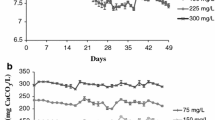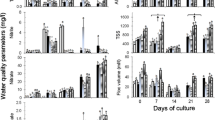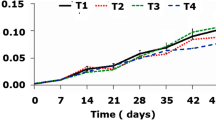Abstract
In cultures of the Litopenaeus vannamei with biofloc, the concentrations of nitrate rise during the culture period, which may cause a reduction in growth and mortality of the shrimps. Therefore, the aim of this study was to determine the effect of the concentration of nitrate on the growth and survival of shrimp in systems using bioflocs. The experiment consisted of four treatments with three replicates each: The concentrations of nitrate that were tested were 75 (control), 150, 300, and 600 mg NO3 −-N/L. To achieve levels above 75 mg NO3 −-N/L, different dosages of sodium nitrate (PA) were added. For this purpose, twelve experimental units with a useful volume of 45 L were stocked with 15 juvenile L. vannamei (1.30 ± 0.31 g), corresponding to a stocking density of 333 shrimps/m3, that were reared for an experimental period of 42 days. Regarding the water quality parameters measured throughout the study, no significant differences were detected (p > 0.05). Concerning zootechnical performance, a significant difference (p < 0.05) was verified with the 75 (control) and 150 treatments presenting the best performance indexes, while the 300 and 600 treatments led to significantly poorer results (p < 0.05). The histopathological damage was observed in the gills and hepatopancreas of the shrimps exposed to concentrations ≥300 mg NO3 −-N/L for 42 days, and poorer zootechnical performance and lower survival were observed in the shrimps reared at concentrations ≥300 mg NO3 −-N/L under a salinity of 23. The results obtained in this study show that concentrations of nitrate up to 177 mg/L are acceptable for the rearing of L. vannamei in systems with bioflocs, without renewal of water, at a salinity of 23.




Similar content being viewed by others
References
Alonso A, Camargo JA (2003) Short-term toxicity of ammonia, nitrite, and nitrate to the aquatic snail Potamopyrgus antipodarum (Hydrobiidae, Mollusca). Bull Environ Contam Toxicol 70:1006–1012
Aminot A, Chaussepied M (1983) Manuel des analyses chimiques en milieu marin. Brest, CNEXO
APHA (American Public Health Association) (1998) Standard methods for the examination of water and wastewater. 20st edition. Washington, DC
Avnimelech Y (1999) Carbon/nitrogen ratio as a control element in aquaculture systems. Aquaculture 176:227–235
Baloi M, Arantes R, Schveitzer R, Magnotti C, Vinatea L (2013) Performance of Pacific white shrimp Litopenaeus vannamei raised in biofloc systems with varying levels of light exposure. Aquac Eng 52:39–44
Bendschneider K, Robinson RJ (1952) A new spectrophotometric method for the determination of nitrite in sea water. J Mar Res 11:87–96
Bhavan PS, Geraldine P (2000) Histopathology of the hepatopancreas and gills of the prawn Macrobrachium malcolmsonii exposed to endosulfan. Aquat Toxicol 50:331–339
Bratvold D, Browdy CL (2001) Effects of sand sediment and vertical surfaces (AquaMats™) on production, water quality, and microbial ecology in an intensive Litopenaeus vannamei culture system. Aquaculture 195:81–94
Burford MA, Thompson PJ, McIntosh RP, Bauman RH, Pearson DC (2003) Nutrient and microbial dynamics in high-intensity, zero-exchange shrimp ponds in Belize. Aquaculture 219:393–411
Camargo JA, Alonso A, Salamanca A (2005) Nitrate toxicity to aquatic animals: a review with new data for freshwater invertebrates. Chemosphere 58:1255–1267
Campos BR, Miranda-Filho K, D’Incao F, Poersch L, Wasielesky W (2012) Toxicidade aguda da amônia, nitrito e nitrato sobre os juvenis de camarão-rosa Farfantepenaeus brasiliensis (Latreille, 1817) (Crustacea: Decapoda). Atlântica 34:75–81
Castille FL, Lawrence AL (1981) The effect of salinity on the osmotic, sodium and chloride concentrations in the hemolymph of euryhaline shrimps of the genus Penaeus. Comp Biochem Physiol 68A:75–80
Chen S, Ling J, Blancheton JP (2006) Nitrification kinetics of biofilm as affected by water quality factors. Aquacult Eng 34:179–197
Cheng SY, Chen JC (2002) Study on the oxyhemocyanin, deoxyhemocyanin, oxygen affinity and acid–base balance of Marsupenaeus japonicus following exposure to combined elevated nitrite and nitrate. Aquat Toxicol 61:181–193
Cheng SY, Tsai SJ, Chen JC (2002) Accumulation of nitrate in the tissues of Penaeus monodon following elevated ambient nitrate exposure after different time periods. Aquatic Toxicol 56:133–146
Crab R, Defoirdt T, Bossier P, Verstraete W (2012) Biofloc technology in aquaculture: beneficial effects and future challenges. Aquaculture 356–357:351–356
De Schryver P, Crab R, Defoirdt T, Boon N, Verstraete W (2008) The basics of bioflocs technology: the added value for aquaculture. Aquaculture 277:125–137
FAO (Food and Agriculture Organization of the United Nations) (2001) Asia Diagnostic Guide to Aquatic Animal Diseases. FAO Fisheries Technical Paper 402/2
Furtado PS, Poersch LH, Wasielesky W Jr (2011) Effect of calcium hydroxide, carbonate and sodium bicarbonate on water quality and zootechnical performance of shrimp Litopenaeus vannamei reared in bio-flocs technology (BFT) systems. Aquaculture 321:130–135
Gaona CAP, Poersch LH, Krummenauer D, Foes GK, Wasielesky W Jr (2011) The effect of solids removal on water quality, growth and survival of Litopenaeus vannamei in a biofloc technology culture system. IJRA 12:54–73
Jory DE, Cabreras RT, Durwood MD, Fegan D, Lee GP, Lawrence AL, Jackson JC, Mcintosh PR, Castañeda AJ (2001) A global review of shrimp feed management: status and perspectives. Aquaculture the World Aquaculture Society, Baton Rouge
Krummenauer D, Cavalli RO, Poersch LH, Wasielesky W (2011) Superintensive culture of white shrimp, Litopenaeus vannamei, in a biofloc technology system in southern Brazil at different stocking densities. J World Aquac Soc 42:726–733
Kuhn DD, Smith SA, Boardman GD, Angier MW, Marsh LFJ, George J (2010) Chronic toxicity of nitrate to Pacific white shrimp, Litopenaeus vannamei: impacts on survival, growth, antennae length, and pathology. Aquaculture 309:109–114
Lightner DV, Redman RM (1998) Shrimp diseases and current diagnostic methods. Aquaculture 164:201–220
Lin YC, Chen JC (2001) Acute toxicity of ammonia on Litopenaeus vannamei (Boone) juveniles at different salinity levels. J Exp Mar Biol Ecol 259:109–119
Lin YC, Chen JC (2003) Acute toxicity of nitrite on Litopenaeus vannamei (Boone) juveniles at different salinity levels. Aquaculture 224:193–201
Mcintosh BJ, Samocha TM, Jones ER, Lawrence AL, Mckee DA, Horowitz S, Horowitz A (2000) The effect of a bacterial supplement on the high-density culturing of Litopenaeus vannamei with low-protein diet on outdoor tank systemand no water exchange. Aquacult Eng 21:215–227
Moss SM, Arce SM, Argue BJ, Otoshi CA, Calderon FR, Tacon AG (2001) Greening of the blue revolution: efforts toward environmentally responsible shrimp culture. In: Browdy CL, Jory DE (eds) The new wave. Proceedings of the special session on sustainable shrimp culture, Aquaculture 2001. The World Aquaculture Society, Baton Rouge, USA, pp 1–19
Poersch LH, Santos MHS, Miranda KF, Wasielesky W (2007) Efeito agudo do nitrato sobre alevinos da tainha Mugil platanus (Pisces: Mugilidae). Bol Inst Pesca Sao Paulo 33(2):247–252
Ray JA, Lewis BL, Browdy CL, Leffler JW (2010) Suspended solids removal to improve shrimp (Litopenaeus vannamei) production and an evaluation of a plant-based feed in minimal-exchange, superintensive culture systems. Aquaculture 299:89–98
Samocha TM, Lawrence AL, Collins CR, Emberson CR, Harvin JL, Van Wyk PM (2001) Development of integrated, environmentally sound, inland shrimp production technologies for Litopenaeus vannamei. In: Browdy CL, Jory DE (eds) The new wave. Proceedings of the special session on sustainable shrimp culture, Aquaculture 2001. The World Aquaculture Society, Baton Rouge, USA, pp 64–75
Samocha TM, Patnaik S, Speed M, Ali AM, Burger JM, Almeida RV, Ayub Z, Harisanto M, Horowitz A, Brook DL (2007) Use of molasses as carbon source in limited discharge nursery and grow-out systems for Litopenaeus vannamei. Aquac Eng 36:184–191
Samocha TM, Wilkenfeld JS, Morris TC, Correia ES, Hanson T (2010) Intensive raceways without water exchange analyzed for White shrimp culture. Global Aquac Advocate 13:22–24
Sokal RR, Rohlf FJ (1969) Biometry. Principle and practices of statistics in biological research. W. H. Freeman, San Francisco
Strickland JDH, Parsons TR (1972) A practical handbook of seawater analysis. Fishery Research Board Canada, Ottawa
Tsai S-J, Chen J-C (2002) Acute toxicity of nitrate on Penaeus monodon juveniles at different salinity levels. Aquaculture 213:163–170
UNESCO (1983) Chemical methods for use in marine environmental monitoring. Manual and Guides 12, Intergovernmental Oceanographic Commission. Paris, France
Van Wyk P, Scarpa J (1999) Water quality and management. In: Van Wyk P et al (eds) Farming marine shrimp in recirculating freshwater systems. Florida department of agriculture and consumer services, Tallahassee, pp 128–138
Wasielesky W, Atwood H, Stokes A, Browdy CL (2006) Effect of natural production in a zero exchange suspended microbial floc based super-intensive culture system for white shrimp Litopenaeus vannamei. Aquaculture 258:396–408
Weirich CR, Browdy CL, Bratvold D, McAbee BJ, Stokes AD (2002) Preliminary characterization of a prototype minimal exchange super-intensive shrimp production system. In: Proceedings of the 4th international conference on recirculating aquaculture. Virginia Tech University, Blacksburg, Virginia, USA, pp 255–270
Wickins JF (1976) The tolerance of warm-water prawns to recirculated water. Aquaculture 9:19–37
Zar JH (1996) Biostatistical analysis, 3rd edn. Prentice Hall, New Jersey
Acknowledgments
The authors are grateful for the financial support provided by the National Council for Scientific and Technological Development (CNPq), the Ministry of Fishery and Aquaculture (MPA), and the Coordination for the Improvement of Higher Level Personnel (CAPES). Special thanks go to Centro Oeste Rações S.A. for donating the experimental diets. W.J. Wasielesky Jr. and L.H. Poersch are research fellows at CNPq.
Author information
Authors and Affiliations
Corresponding author
Rights and permissions
About this article
Cite this article
Furtado, P.S., Campos, B.R., Serra, F.P. et al. Effects of nitrate toxicity in the Pacific white shrimp, Litopenaeus vannamei, reared with biofloc technology (BFT). Aquacult Int 23, 315–327 (2015). https://doi.org/10.1007/s10499-014-9817-z
Received:
Accepted:
Published:
Issue Date:
DOI: https://doi.org/10.1007/s10499-014-9817-z




